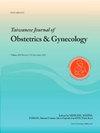对家族性地中海热病患者产科过程的回顾性评估:一家三级风湿病诊所的三年经验
IF 2
4区 医学
Q2 OBSTETRICS & GYNECOLOGY
引用次数: 0
摘要
目的地中海家族性高热(Familial Mediterranean Fever,FMF)是一种遗传性自身炎症性疾病,对育龄期男女均有影响。在这项研究中,我们旨在从母体和胎儿两方面研究 FMF 与妊娠之间的关系。材料和方法在这项回顾性、单中心、描述性研究中,我们分析了 40 名 FMF 患者的 95 次妊娠。临床和人口统计学数据均来自患者的病历。为防止回忆偏差,我们仅对每位患者的最后一次妊娠进行了评估,以了解其疾病活动情况以及在妊娠期间使用或更换药物的情况。结果患者确诊时的中位年龄为 22 岁,首次妊娠年龄为 26 岁。最后一次怀孕时,FMF 的中位持续时间为 8(0-23)年。8名患者(20%)至少有一次通过辅助生殖技术(IVF)怀孕,34名患者(85%)至少有一次自然怀孕。32 名患者(80%)在怀孕前病情得到缓解,8 名患者(20%)病情处于临床活动期。妊娠期间,23 名患者(57.5%)的临床病程和发作频率有所改善,10 名患者(25.0%)的病程稳定,7 名患者(17.5%)的病情恶化。活产率为 70.0%,流产率为 28.9%,早产率为 8.1%,子痫前期为 5.0%,仅发现 1 例软骨发育不全为先天性胎儿畸形。妊娠过程中最重要的产科问题、并发症和胎儿不良结局是体外受精需求、流产和剖宫产率增加。FMF 本身或使用秋水仙碱不会增加先天性畸形的风险。本文章由计算机程序翻译,如有差异,请以英文原文为准。
Retrospective evaluation of obstetric processes in patients with Familial Mediterranean Fever's disease: The three years experience of a tertiary rheumatology clinic
Objectives
Familial Mediterranean Fever (FMF) is a hereditary autoinflammatory disease affecting both genders in reproductive age. In this study, we aimed to investigate the relation between FMF and pregnancy on both maternal and fetal aspects.
Material and methods
In this retrospective, single-center, descriptive study we analysed total of 95 pregnancies of 40 FMF patients. Clinical and demographic data were obtained from patients’ records. To prevent recall bias, only the last pregnancy of each patient was evaluated for disease activity and use or revision of medications during pregnancy.
Results
The median age of the patients at diagnosis was 22 and the first pregnancy age was 26 years. The median duration of FMF at last pregnancy was 8 (0–23) years. Eight (20%) patients had at least 1 pregnancy via assisted reproductive techniques (IVF), while 34 (85%) patients had at least 1 spontaneous pregnancy. While 32 patients were in remission (80%) before pregnancy, 8 were clinically active (20%). Improvement in clinical course and attack frequency during pregnancy was observed in 23 patients (57.5%), stable course in 10 (25.0%), and worsening in 7 (17.5%). The rate of live birth was 70.0%, abortus was 28.9%, preterm labor was 8.1%, pre-eclampsia was 5.0%, and only 1 achondroplasia as congenital fetal abnormality was observed.
Conclusion
FMF did not constitute a contraindication for pregnancy. The most important obstetric problems, complications, and negative fetal outcomes in the course of pregnancy are increased IVF requirement, abortion, and cesarean rates. There is no increase in the risk of congenital malformations due to FMF itself or use of colchicine.
求助全文
通过发布文献求助,成功后即可免费获取论文全文。
去求助
来源期刊

Taiwanese Journal of Obstetrics & Gynecology
OBSTETRICS & GYNECOLOGY-
CiteScore
3.60
自引率
23.80%
发文量
207
审稿时长
4-8 weeks
期刊介绍:
Taiwanese Journal of Obstetrics and Gynecology is a peer-reviewed journal and open access publishing editorials, reviews, original articles, short communications, case reports, research letters, correspondence and letters to the editor in the field of obstetrics and gynecology.
The aims of the journal are to:
1.Publish cutting-edge, innovative and topical research that addresses screening, diagnosis, management and care in women''s health
2.Deliver evidence-based information
3.Promote the sharing of clinical experience
4.Address women-related health promotion
The journal provides comprehensive coverage of topics in obstetrics & gynecology and women''s health including maternal-fetal medicine, reproductive endocrinology/infertility, and gynecologic oncology. Taiwan Association of Obstetrics and Gynecology.
 求助内容:
求助内容: 应助结果提醒方式:
应助结果提醒方式:


